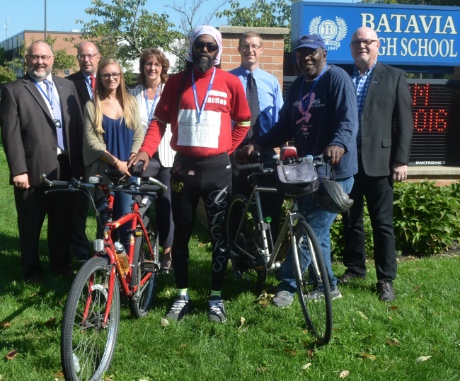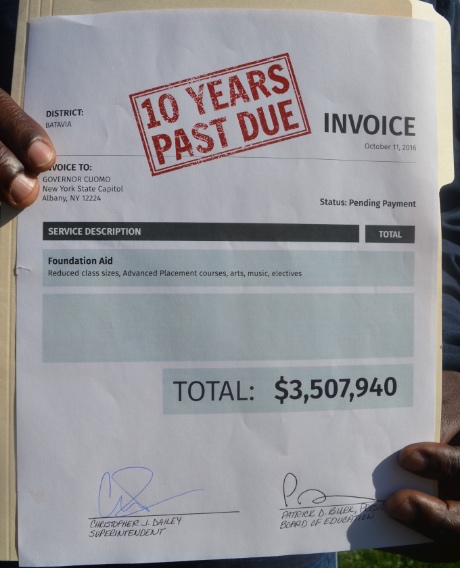
Pictured from left: BHS Principal Scott Wilson, Business Administrator Scott Rozanski, Board of Education (BOE) Student Ex-Officio Member Madison Moore, Executive Director of Curriculum and Instruction Molly Corey, Citizen Action Member Eddie Jones, BHS teacher and Batavia Teachers Association President Mark Warren, Citizen Action Member David Cates, and Board of Education President Patrick Burk. (Superintendent of Schools Christopher Dailey was in Albany on school business so was unavailable.)
Submitted photos and press release.
The Batavia City School District welcomed Citizen Action of Western New York activists David Cates, Eddie Jones, and Samantha Nephew as they made a stop at Batavia High School this week on their way to Albany with an important message about education.
New York State has reneged on its constitutional and court ordered obligation to students, particularly students in high needs* districts such as Batavia, and it is payback time.
Board of Education President Patrick Burk presented Cates and Jones a “Past Due” invoice for $3.5 million to be delivered to the Governor’s Office on behalf of the Batavia City School District.
The trio is collecting other such invoices and statements from school districts as they travel to the state capital where they will meet up on Tuesday with like-minded activists and, they hope, lawmakers. Cates and Jones -- who both work in the educational field and whose inspiration for the trip comes from their own children as well as from working with other young people in their community -- are biking the Buffalo to Albany route with Nephew following by car.
Other affiliates of Citizen Action of New York from various parts of the state are walking to Albany.
The group’s intention is to spur lawmakers to pay the money owed to school districts in New York, as dictated by a 2006 court ruling which then was translated into the Education Budget and Reform Act of 2007. The court ruling affirmed the State’s constitutional obligation to provide essential resources for a quality education to all public school children in the state in order to graduate college-ready or career-ready citizens, regardless of their zip code. Subsequently, the legislation established a formula, to be phased in over a four-year period, designed to ensure adequate and equitable funding for all schools by calculating state aid based on students' needs and a district’s ability to raise revenue.
Legislators obeyed the law for two years, but when the economy took a downturn, they stopped obeying it and have not looked back. According to the Education Law Center, first, aid was frozen in 2009 at 37.5 percent of the four-year target. Then for the next two years, aid was cut by $2.7 billion in the name of Gap Elimination Adjustment that used school aid to balance the state’s overall budget. The GEA money has recently been restored, but the Reform Act has yet to be rekindled.
Thus, the bill for $3.5 million.
Batavia administrators, teachers, and Board of Education trustees agree that $3.5 million could provide a lot of “more and better” for our students, and ideas of how to spend it abound: reinstate courses; reduce class sizes; provide a greater variety of courses; offer multiple sections of selected courses so more students could take advantage of opportunities; hire more aides for classrooms; increase individualized instruction; increase professional development opportunities; and/or lower taxes.
“It’s important to make sure all of our students have their needs met,” said Burk as he thanked Cates and Jones for highlighting the issue. “This could do a lot.”
*“High needs” is typically defined as having a high percentage of students who qualify for free or reduced-priced meals.

